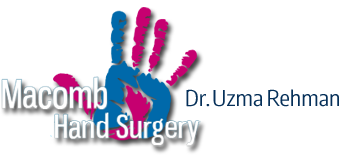Joint Replacement Surgery of the Hand
Joint replacement surgery is a common but life-changing procedure that replaces a painful, non-functioning or destroyed joint with an artificial joint.
This procedure is typically used to treat the effects of severe arthritis on certain joints, but can also be employed to treat other joint injuries or diseases.
Why Joints Need to be Replaced
In a healthy joint, the bones have a smooth surface on their ends made of a type of cartilage called articular cartilage. This sleek surface allows one bone to glide easily against the other in the “joints” where the bones meet. The joints are also lubricated by a thin layer of fluid that keeps the bones gliding smoothly.
Arthritis and some other conditions or injuries can cause the articular cartilage to wear out and/or result in insufficient amounts of joint fluid. The joints then become stiff and painful. Eventually mobility may be reduced and the joints may even become crooked or misshapen.
How Joint Replacement Surgery Works
Finger joints (PIP), knuckle joints (MP) and wrist joints can all be replaced with artificial joints.
During joint replacement surgery, the damaged bone and lining structures of the joint are removed, and the surgeon inserts new mechanical joints in their place.
The artificial joint allows the joints to move again with little or no pain, as well as restoring motion to the joint. Joint replacement surgery can also improve the appearance and alignment of crooked joints.
Artificial joints be made of metal or plastic and/or a specific carbon-coated material.
Recovery after Joint Replacement Surgery
Specific splints are typically used to stabilize the joint after replacement surgery, depending on which joint was replaced and the technique of surgery that was done.
In almost all cases, physical therapy of the hand by a trained hand therapist is required after joint replacement surgery in the fingers, thumb(s) or wrist. This will ensure the best results after surgery, and the most complete recovery with the greatest mobility and function of the new joint.
Always follow your hand surgeon and physical therapists’ direction for recovery. With proper aftercare, complications are extremely rare – but call your hand surgeon if you experience any sudden increase in pain or swelling, redness, heat and/or it becomes crooked.
Top Joint Replacement Surgery Bloomfield Hills
If you are suffering from an injury or pain in your joints, fingers, wrist, elbow or arm, contact board certified Bloomfield Hills hand surgeon Doctor Rehman for a comprehensive evaluation and consultation. As with most medical conditions, early detection, awareness, and a prevention or treatment plan is the most effective way to combat the effects of arthritis and other joint problems.
Doctor Rehman will assess your individual situation, and prescribe the treatments that are best for your condition.

